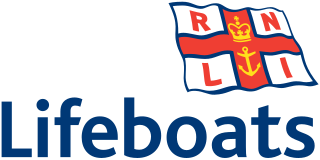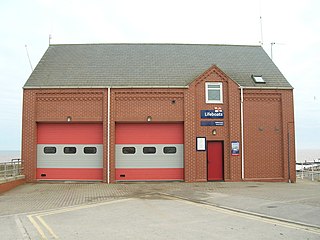
The Royal National Lifeboat Institution (RNLI) is the largest charity that saves lives at sea around the coasts of the United Kingdom, the Republic of Ireland, the Channel Islands, and the Isle of Man, as well as on some inland waterways. It is one of several lifeboat services operating in the same area.

The Severn class is the largest lifeboat operated by the Royal National Lifeboat Institution (RNLI). The class, which is 17.3 metres long, was introduced in to service in 1996. It is named after the River Severn, the longest river in Great Britain. The lifeboats are stationed at 35 locations around the coasts of the United Kingdom and Ireland and can provide coverage up to 50 miles (80 km) out to sea.

Tamar-class lifeboats are all-weather lifeboats (ALBs) operated by the Royal National Lifeboat Institution (RNLI) around the coasts of Great Britain and Ireland. They have replaced the majority of the older Tyne ALBs. The prototype was built in 2000 and 27 production boats were constructed between 2006 and 2013.

The Shannon-class lifeboat is the latest class of lifeboat currently being deployed to the RNLI fleet to serve the shores of the British Isles. The Shannon class is due to replace the Mersey class carriage-launched lifeboat, the remaining Tyne-class lifeboats, and to also replace the Trent-class lifeboats in due course.
Since its inception, the Royal National Lifeboat Institution (RNLI) has provided lifeboats to lifeboat stations in the United Kingdom and Ireland.
A rescue lifeboat is a boat rescue craft which is used to attend a vessel in distress, or its survivors, to rescue crew and passengers. It can be hand pulled, sail powered or powered by an engine. Lifeboats may be rigid, inflatable or rigid-inflatable combination-hulled vessels.

St Ives Lifeboat Station is the base for Royal National Lifeboat Institution (RNLI) search and rescue operations at St Ives, Cornwall in the United Kingdom. The first lifeboat was built for the town in 1840 and the present boathouse was opened in 1994. It operates a Shannon-class all weather boat (AWB) and a D-class (IB1) inshore lifeboat (ILB).

Mudeford Lifeboat Station is the base for Royal National Lifeboat Institution (RNLI) search and rescue operations at Mudeford, Christchurch, Dorset in England. The first lifeboat was stationed on Mudeford Quay 1963 and the present station was opened in 2003. It operates an Atlantic 85 inshore lifeboat (ILB).

Poole Lifeboat Station is the base for Royal National Lifeboat Institution (RNLI) search and rescue operations at Poole, Dorset in England. The first lifeboat was stationed at Poole Harbour in 1865 and the present station was opened in 1988. Since November 2016 it has operated two inshore lifeboats, an Atlantic 85 and a D class.

Cardigan Lifeboat Station, at Poppit Sands, North Pembrokeshire, near Cardigan, Ceredigion, Wales, is a Royal National Lifeboat Institution (RNLI) lifeboat station opened in 1849. The station closed in 1932 but reopened in 1971 as an inshore lifeboat station.

Calshot Lifeboat Station is located on Calshot Spit near the village of Calshot, Hampshire, and is on the southern bank of the open end of Southampton Water, on the south coast of England. The station is owned and operated by the Royal National Lifeboat Institution (RNLI) and currently operates two inshore lifeboats. They are an Atlantic 85 called Max Walls (B-860) and a D-class (IB1) called RNLB Willett (D-748).

Flamborough Lifeboat Station is a Royal National Lifeboat Institution (RNLI) lifeboat station located at Flamborough in the East Riding of Yorkshire, England. There used to be two lifeboat stations at Flamborough; one on the north side of Flamborough Head, and on one the south side. Since 1993, the village has just one lifeboat station on the southern side of Flamborough Head. The station operates an ILB.

Bridlington Lifeboat Station is a Royal National Lifeboat Institution (RNLI) lifeboat station based in Bridlington, East Riding of Yorkshire, England. Having been instituted in 1805, it is the oldest working RNLI lifeboat location in the Yorkshire and the Humber region.

Withernsea Lifeboat Station is a Royal National Lifeboat Institution (RNLI) lifeboat station located in the town of Withernsea, East Riding of Yorkshire, England. It is one of four RNLI stations in the East Riding of Yorkshire, with another five in North Yorkshire.

The Humber Lifeboat Station is located on Spurn Point in the East Riding of Yorkshire, England. The station is one of nine Royal National Lifeboat Institution (RNLI) lifeboat stations situated along the Yorkshire Coast and the most southerly of them all. It is the only lifeboat station in the United Kingdom that is staffed full-time by a professional RNLI crew; this is due to the waters around this part of the coast being so dangerous and the station's remoteness from the mainland.

Scarborough Lifeboat Station is a Royal National Lifeboat Institution (RNLI) operated lifeboat station in Scarborough, North Yorkshire, England. A lifeboat was established at Scarborough in 1801, which makes it the third oldest lifeboat station in the United Kingdom.

Filey Lifeboat Station is a Royal National Lifeboat Institution (RNLI) lifeboat station located in the town of Filey, North Yorkshire, England. It is one of nine operational RNLI lifeboat stations situated on the Yorkshire Coast.

Whitby Lifeboat Station is a Royal National Lifeboat Institution (RNLI) lifeboat station located in Whitby, North Yorkshire, England. It is one of nine situated along the Yorkshire coast. Whitby has had a lifeboat station since 1802, with the RNLI responsible since 1861. In its 200 plus year history, Whitby has had five different lifeboat stations. A sixth lifeboat and station was located at Upgang, just up the coast from Whitby, and whilst it was considered separate from Whitby, it was crewed by men from the Whitby lifeboat.

Staithes and Runswick Lifeboat Station is a Royal National Lifeboat Institution (RNLI) lifeboat station based in the village of Staithes, North Yorkshire, England. The station was first opened in 1875 but has been closed for two periods between then and the 21st century due to a decline in the fishing industry and the ability to supply people to crew the lifeboat. It is now host to an Inshore Lifeboat (ILB).


















